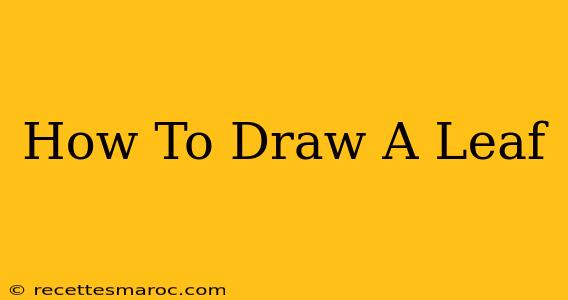Drawing leaves might seem simple, but capturing their intricate details and natural variations requires practice and understanding. This guide provides a step-by-step approach to drawing leaves, catering to both beginners and those looking to refine their skills. Whether you're aiming for photorealism or a more stylized approach, mastering leaf drawing enhances your overall botanical illustration abilities and adds depth to your nature-inspired artwork.
Understanding Leaf Structure: The Foundation of Realistic Drawing
Before you start sketching, it’s crucial to understand the basic structure of a leaf. Leaves aren't just simple shapes; they possess distinct features:
- Midrib: The central vein running down the length of the leaf.
- Veins: Smaller veins branching out from the midrib, creating a network supporting the leaf's structure. Observe how these veins vary between different types of leaves.
- Leaf Margin: The edge of the leaf – it can be smooth, serrated (toothed), lobed (with rounded projections), or even wavy.
- Leaf Blade (Lamina): The flat, broad part of the leaf. Its shape is highly variable.
- Petiole (Leaf Stalk): The stem connecting the leaf to the branch.
Step-by-Step Guide to Drawing a Simple Leaf
Let's begin with a basic leaf shape, perfect for beginners:
Step 1: The Midrib and Overall Shape
Start by lightly sketching a central line – your midrib. Then, lightly sketch the overall shape of your leaf, keeping it simple initially. Think of an oval or elongated shape to begin. Don't press hard on your pencil; these are guidelines.
Step 2: Adding the Veins
From the midrib, lightly sketch smaller veins branching outwards. Don't make them perfectly symmetrical; natural veins are irregular and organic. Pay attention to how they curve and connect.
Step 3: Defining the Leaf Margin
Now, refine the leaf's edge. Is it smooth, serrated, or lobed? Use gentle curves and variations to create a natural look. Avoid overly sharp or perfect lines.
Step 4: Shading and Texture
Add shading to give your leaf depth and dimension. Observe how light falls on a real leaf – usually, there are lighter areas and darker shadows. Use shading to suggest the leaf's texture and form. You can use hatching or cross-hatching techniques to achieve varied tones.
Step 5: Final Touches and Details
Once you're happy with the shading, you can add fine details. You might add subtle variations in color, texture, or even small imperfections to make the leaf more realistic.
Drawing Different Types of Leaves: Expanding Your Skills
Once you've mastered the basic leaf, experiment with different types:
- Oak Leaves: Characterized by their lobed margins. Focus on the irregular shapes of the lobes.
- Maple Leaves: Known for their distinct palmate (hand-shaped) lobes. Pay close attention to the sharp angles and the delicate veins.
- Willow Leaves: Long, slender leaves with smooth margins. Concentrate on the gentle curves and consistent tapering.
Beyond Basic Techniques: Mastering Advanced Leaf Drawing
To take your leaf drawing to the next level, explore these advanced techniques:
- Perspective: Consider how perspective affects the leaf's shape and size depending on its position in relation to the viewer.
- Light and Shadow: Study how light interacts with the leaf's surface, creating highlights and shadows that enhance its three-dimensionality.
- Texture: Experiment with different shading techniques to capture the subtle textures of a leaf's surface, from smooth to rough.
- Reference Photos: Always use real-life references to improve accuracy and understanding. Observe the intricate details of different leaf types.
Practice Makes Perfect: The Key to Mastering Leaf Drawing
Remember, consistent practice is crucial for improvement. Draw various leaves from different plants, experimenting with different styles and techniques. The more you draw, the better you'll become at capturing the beauty and complexity of leaves. So grab your pencil and paper, and start drawing!

